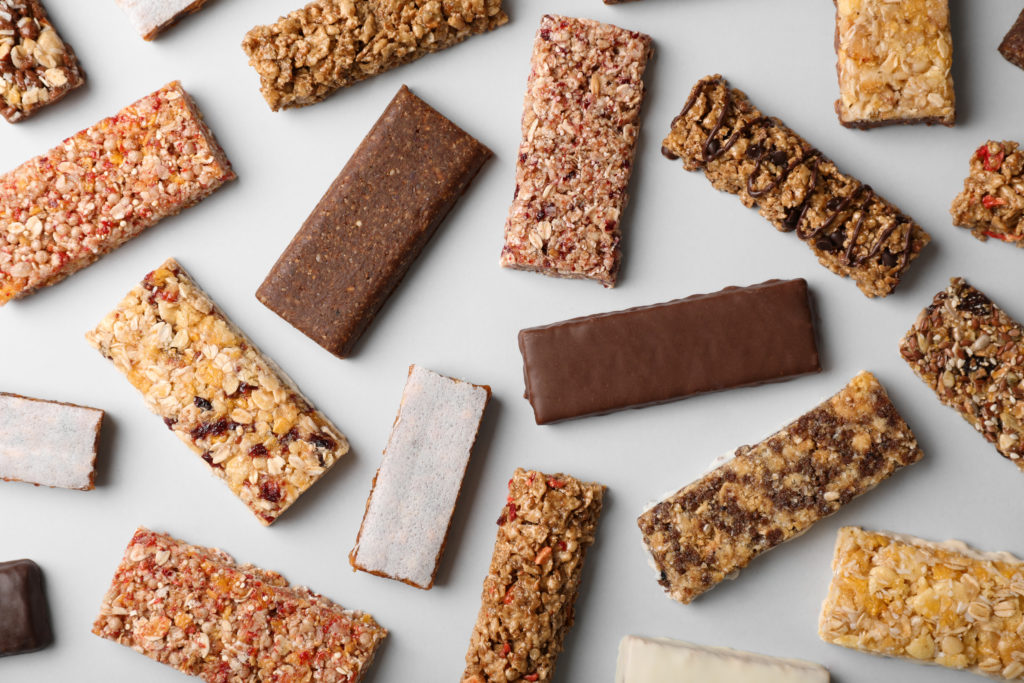Are you always on the go? Between getting to work, the gym, and running whatever other errands you and your family have going on, it can certainly feel like it! Staying fueled for whatever lifestyle you have is really important, and if you’re rushing somewhere before or after your workout, thinking about protein matters, too. Protein bars might seem like the solution to your problem: they’re prepackaged, easy to find at the grocery store, usually delicious and require zero meal prep! However, it’s best to eat bars sparingly, rather than as your primary protein source. While they’re great in a pinch, it’s best to get your protein from whole food sources and snacks like hard-boiled eggs, nut butter, hummus, nuts and seeds or cheese.
Now, we totally understand that some days, meal prep just isn’t going to happen, much less healthy snack prep! It’s better to have a protein bar around than to go hungry, or to miss that crucial period after your workout when your body wants to re-fuel. That being said, there are a lot of good protein bars out there, but some rank higher than others. Let’s take a look at some of the most important information to consider when looking for a healthy protein bar that fits into your healthy eating plan.
Watch the Calories
Like all packaged foods, make sure to read the nutrition information. Some protein bars fall under the category of meal replacement bars, most of which are 400+ calories. That’s equivalent to eating one egg, two egg whites, three slices of light toast, strawberries, and a veggie sausage patty! If you’re eating a bar for a snack, it should be closer to 200 calories. Those extra calories can contribute to weight gain, especially if you think you’re just eating a pre or post workout snack!
Beware of Certain Ingredients
If you only have time at the grocery store to read one thing on the packaging beyond the bar’s flavor, make it the ingredients list! The first five main ingredients (of any nutrition label) make up the bulk of the nutrients. If you see these listed as some of the top ingredients, we would recommend skipping that bar altogether.
- Soy Protein Isolate & Soy Lecithin: “Seriously processed soy junk…” says Lauren Slayton, MS, RD, author of “The Little Book of Thin.” There are better protein sources to be found!
- High Fructose Corn Syrup & Sucralose: “High-fructose corn syrup is generally a clue that the bar company doesn’t care about high-quality ingredients,” says Slayton. It’s an artificial sweetener that can also make the grams of sugar spike!
- Sugar alcohols, which show up on labels as erythritol, mannitol, sorbitol, xylitol, lactitol, isomalt, maltitol, and hydrogenated starch hydrolysate. You may think that a bar is healthy if it has fewer grams of sugar, but beware: sometimes those grams of sugar are hiding as sugar alcohols, which are artificial sweeteners and harder for the body to digest.
- Inulin: “When consumed in large amounts, it can actually do the opposite of promote healthy digestion—it can give you an upset stomach, diarrhea, gas, bloating, or constipation,” says McKel Hill, MS, RD, creator of Nutrition Stripped.
- Soluble Corn Fiber: May result in gastrointestinal effects.
The best protein bars will have a short ingredient list composed mainly of high-quality, and ideally whole food, ingredients. If you’re gluten-free, the label on your bar is particularly important! Many bars contain lots of unfamiliar ingredients, so we can’t always tell if they’re gluten-free just by reading the ingredients list. Look for bars that are specifically labeled gluten-free by the manufacturer if you follow a gluten-free diet.
Macronutrients Are Key
Macronutrients are those nutritional components of your diet that are needed in relatively large amounts. You need protein, carbohydrates, fat, and macrominerals. It’s a great idea in general to start getting into the habit of reading nutrition labels so you understand what gaps are being filled in your daily macronutrient intake, especially in regards to protein. The average person can only absorb 25-30 grams of protein in one sitting (one recent study looked into this); the rest will go to waste. Here’s a few things to look for in protein bars.
Serving Size
Bars often hide their calorie content by splitting the bar into two servings, and only displaying the nutritional value for one serving – even though most people eat the entire bar in one sitting. It’s a sneaky move that can unfortunately have negative effects on your body weight! Make sure the serving size aligns with the protein content and calories you’re looking for, as part of your healthy diet.
Carbohydrates
Ideally, your protein bar will have relatively low carbohydrates, under 20 grams. Of course, there’s nothing wrong with carbohydrates, and your body needs them for fuel, but a good protein bar should be focused on the protein content, rather than the carbs. Some CLIF bars, for example, contain around 45 grams of carbs. That’s when you know you’ve found a meal replacement bar, rather than just a protein supplement. Most Luna bars, on the other hand, contain 20 grams of carbs or less, making Luna bars a better choice for a snack.
Another important thing to keep in mind with carbohydrates is the grams of sugar, which fall under carbs. If you start reading nutrition information, you’ll be shocked to find how many grams of sugar are hiding in what’s supposed to be a healthy protein bar! The Luna bar we looked at above, for example, contained 14 grams of sugar. For women, that’s over half the recommended grams of sugar you should consume in a day, in one bar!
Just about every good protein bar is going to contain some amount of sugar, but you also don’t want your protein bar to turn into a candy bar! How much sugar should you look for? For men, the recommended daily amount of sugar is 36 grams or less. For women, it’s 25 grams of sugar. You don’t want a bar to eat up your entire days’ allotment of sugar, so we suggest aiming for 10 grams of added sugar or less. A bar with too much sugar can spike your blood sugar, which can cause your energy levels to crash later in the day when your blood sugar drops.
Fiber
In addition to watching out for sugar, you’ll also want to count the grams of fiber in your bar. The grams of fiber to look out for depends on your needs from the protein bar! A bar with more grams of fiber will keep you satiated and feeling full longer. The more grams of fiber in a bar, the longer it takes to digest! On the other hand, the fewer grams of fiber a bar has, the quicker your body can digest it. So for people looking for a meal replacement bar, more fiber is a good idea, but for those who just need a quick snack to quell hunger, less fiber is the best option!
Protein
Protein is, of course, the key ingredient in a protein bar, but how much protein do you really need? The protein content in protein bars can vary anywhere between 10 grams to 30 grams, in high protein bars. Those high protein bars are best for people following high protein diets to build muscle. For most people not following high protein diets, anywhere between 10 and 20 grams is fine. The Dietary Reference Intake for protein is 0.8 grams of protein per kilogram of body weight, or 0.36 grams per pound. When choosing a protein bar, consider how much protein you eat on a regular day. If it’s low, aim for closer to 20 grams of protein in a protein supplement. If you’re already getting enough protein in your diet, around 10 grams or more is a good choice. Again, if you’re following a high protein diet to actively build muscle mass, you may be working with different numbers.
You’ll also want to think about the type of protein you’re eating in your bar. If you choose animal-based protein, like whey, you’re getting all of your essential amino acids. Plant-based proteins provide some amino acids, but not all, so you might want to look for a plant protein blend if you’re concerned about getting a complete protein.
Fat
Ideally, your protein bar will have less than 10 grams of fat. Fat adds unnecessary calories, and slows down digestion, which isn’t helpful if you’re really hungry! If you can, we recommend looking for monounsaturated fat instead of saturated fat, as it’s better for your cholesterol.
Don’t Skip Meals
Protein bars are quick, convenient, and relatively well-priced compared to some other packaged options you have available in a pinch. But there are plenty of healthy homemade recipe alternatives like these protein bites out there that will help you keep better control of the ingredients. In fact, at Build-a-Bar you can design your own.
When chosen correctly, having a couple bars that you enjoy on hand is a great guard against those times when you’re desperate for a snack or without a meal. If given the choice between a salad and a protein bar, the salad likely offers greater benefits, particularly vitamins, fiber and minerals. If your options are between the drive-thru and a protein bar, however, the bar will hopefully prove just as satisfying with fewer calories. We took a look at some of the most popular protein bars out there to review which are the best!
Lastly, if you know a boost of protein is needed in your diet, consider food options naturally high in protein such as fish, turkey, and eggs. Do yourself a favor and plan the best you can ahead of time; or grab a good bar, then get to a well-balanced meal that’s full of vitamins, minerals and whole foods later!



